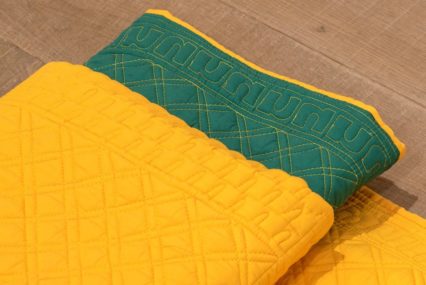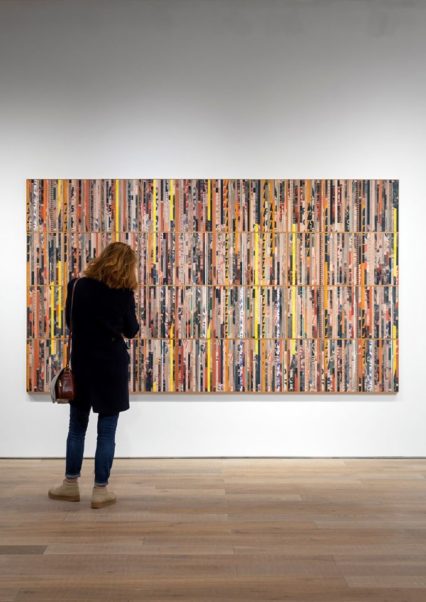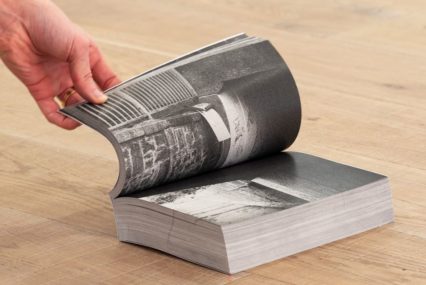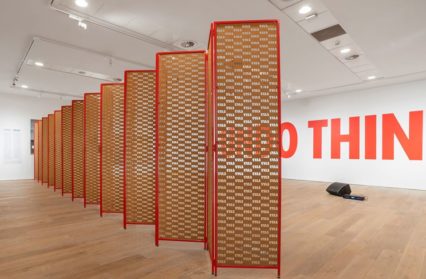Scott Baines reviews Undo Things Done, the Sean Edwards exhibition that made a mark as Wales’s representative at the Venice Biennale in 2019 and until the lockdown sat at Ty Pawb in Wrexham.
“In the early days, people would regularly get lost looking for their own houses, such was the uniformity of the housing and the complexity of its design… what my mum remembers is that every day she would be stopped by someone who needed directions to their new home” – Lynsey Hanley, Estates: An Intimate History.

At the top of the visitor’s comment book is simply written: ‘Diderot’. No, look again. Diddorol. By this point, I’ve been walking around Sean Edwards’ Undo Things Done at Tŷ Pawb for a while and I’m beginning to lose trust in my sensory preceptors from the overflow of information. It was not my initial feeling as I first walked into the gallery, greeted by sparseness of installations that I cannot say to have been expecting. I think such a space would be appropriately complemented by the words of Valery regarding the distance between works:
‘the sense of sight is harassed by this abuse of space in a collection and, similarly, intelligence is offended by the tight packing of important works’.
One of the main themes of the exhibition is an expectation, specifically an attempt to capture the condition of
‘not expecting much’ and translating it into a shared visual language. It’s a common feeling to many people across the country that originates in a mindset derived from more than one source. These may be the feeling of intrepid isolation on an island separated from the continent, the Victorian stoicism whereby the establishment had people ‘live within their means and humour that plays on the incongruity between social aspiration and philosophical realism.
However, the more important theme, undoing, is woven into the title. What is done and what is left undone represent the limits of interpretation. Indeed, the very process of analysis – from the Greek lyein, to unfasten – is tied up in these limits. Some visitors will have knotted themselves up in puzzlement attempting to bestow adequate response, meaning and explanation to what it was with which they were presented. But to paraphrase what Edwards has said elsewhere, there exists ‘the institutional wish to ease the consumption via over explanation’. The legitimacy of an object should not be determined by its capacity for meaning.
To complement this perspective is an essay by Clive Cazeaux in the exhibition booklet called ‘The Poetics of the Fragment’, claiming that art ‘requires the experience of the viewer for its completion’. As the empty spaces slowly filled with people, there was no stipulation for quiet as the radio play, ‘Refrain’, began. It was as if not only the spectators but the functional objects in the room such as plug sockets, wires and sandbags, became a part of the artwork. The exhibition thus presents an object-oriented ontology insofar as it decentres human subjectivity by centring on the human body.
This is exemplified in ‘Nails (or inheriting absence)’, the large canvas of several toes, and my immediate connotation is what Deleuze refers to as the imperceptible. The speed at which toenails grow back is something that transcends the incessant grind of everyday life, something so infinitesimally alien that it’s incomprehensible to minds that have grown up at this height, at this speed, in only so many dimensions. It represents the nudity that only a human can feel, but at such an imposing distance that any sexual or aesthetic pleasure has been eroded in substitute for a pure interrogation of the body, in all its materiality and chance encounters with other bodies.

Confusing the subject-object and cause-effect is redolent of an anecdote Žižek relates of a German officer visiting Picasso painting Guernica. Shocked, he exclaims: ‘Did you do this?’. Picasso replies: ‘No, you did this!’ That context is one of man-made disaster and is, therefore, less tenuously linked to the present exhibition than one would assume, in relation to the climate crisis. Steel and woodwork entitled ‘in parallel with the past i-iv’ were affected by the floods in Venice and could not be exhibited, and has been replaced with a work using the same title, showing the adaptability of the artist to absorb difficult changes.
This acclimatization to difficult material working conditions speaks to a contemporary tone struck by Jean-
Pierre Dupuy in his A Short Treatise on the Metaphysics of Tsunamis. We are required to ‘project ourselves into the time that follows the dreaded event, and to see it in retrospect as an event that was both necessary and improbable’. In the coming decades, water may become just as prominently a dangerous archetype to the phenomenology of artwork as fire has been, from the library at Alexandria to Fahrenheit 451. The concept of the flood concerns itself biblically with cleansing, ecologically with the man-made climate crisis, economically with the archaic refrains to drops in GDP and socially with the desperate fear for the livelihood and property of oneself and those around us. It equally concerns politics as it does philosophy.
Politics permeates the room and what would otherwise be a tantalizingly abstract title, which is painted on
the wall in a Tempo typeface of pure red, Matt emulsion. The wish to undo things, to organise and reorganise society in a more effective way, is the fundamental departure point of all politics. This is why the politics of the status quo cannot help but fall victim to the culture of entertainment and celebrity. Books present that indicate this political explication include Lynsey Hanley’s Respectable, James Bloodworth’s The Myth of Meritocracy and Mike Savage’s Social Class in the 21st Century. Almost as soon as you enter, the folding screen provides a walkway to the work ‘Free School Meals’, with these same words inscribed inside the frame.

It’s a phrase that could be perceived as epitomizing the shame accompanying the differentiated queuing
the system at school, as the guide explains, or as a demanding imperative, connoting similar demands made throughout the centuries for better working and living conditions. With recent ideological polarities being accentuated with the demise of neoliberalism, the return of Marx is yet again a genuine and legitimate talking point. This particular strand of thematics denotes not so much an ontology as a hauntology. For elucidation on the subject, recommended reading is Derrida’s Specters of Marx – which isn’t present at the exhibition – and Mark Fisher’s Ghosts of my Life – which is.
The radio play combines stories from the life of the artist’s mother, Lily Edwards, from her early life in a
Northern Irish Catholic Children’s Home to homelessness amongst many other narrative threads. Its invocation of the prefix ‘un’ is something reiterated on the Welsh Wholecloth quilts. In the exhibition booklet, Elen Phillips writes of the long history of quilting in Wales, experiencing its apotheosis in 1928 when a subsection of the Ministry of Agriculture managed to secure a showcase at Muriel Rose’s Little Gallery in London. The exhibition presents thinking of the fragment insofar as the individual works that are spread relatively far apart from each other can ‘invite allusion, association and poetic leaps between’ them (Cazeaux).
‘DOMS’ is a video showing dominos being constantly rearranged, reminding the spectator of Mallarme’s
religious respect for a chance in Un Coup de Dés. This is so because of the visual similarity between the dice and the domino. But I would venture to say it is also because of the open space of the gallery, redolent of how the poet uses blank space as a counter production to the ‘words on the page’. This returns to the earlier point about the category of ontology – and hauntology – that is employed. Related to the political circumstances and contexts of other installations, it would ultimately signify the aleatory materialism that all objects, including humans, experience as a necessity of existence, as serendipitous significance. The collages, with their splashes of seemingly random letters, punctuated by the long repetition of vowels, is reminiscent of Schwitter’s Ursonate, his own undoing of language and the chance that accompanies such composition. They encompass the plethora of books spread across the tables that provoked my aforementioned cognitive overflow. As Diderot once said, genius presupposes some disorder in the machine.
For information about Ty Pawb and its plans for Undo Things Done by Sean Edwards after the lockdown, keep an eye on their website.
Scott Baines often contributes content surrounding art exhibitions to Wales Arts Review.












